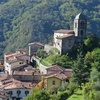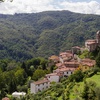Riana
The mediaeval village of Riana is situated on top of a rocky outcrop near the confluence of the Fosso Riomonio with the Serchio river. The elevated position allowed this fort to control a good portion of the Upper Valley of the Serchio, both towards the south and towards the north in the direction of the Garfagnana of the Este.
Tracts of walls are still preserved in Riana, probably datable to the sixteenth century, located mainly along the north and south sides of the village. The only element of a previous era is the bell tower of the XI-XII century: its dating is due to the particular construction technique, visible in the lower portion of the building, and the military function that it definitely had, as demonstrated by the presence of an archer's arrow slit at the base of the tower.
Historical notes
The village was first mentioned in the year 765 as "Vico de Arriana," and was talked about for a long time as such, even when in 994 the bishop of Lucca Gherardo assigned the annuities that the community was required to pay to Rolandinghi di Loppia. At the end of the thirteenth century, with the fall of the noble lords, Riana was included in the Vicariate "a Perpore infra».
The village gained importance in the first half of the fourteenth century, a period in which the centre of Barga spontaneously gave itself over to Florence. As a result of this event,Riana became part of the Vicariate of Gallicano, therefore placing it right on the border with the state of Florence. The village became even more important after the fall of the lordship of Paolo Guinigi, when many neighbouring communities decided to become part of the Este dominions. This meant that the territory of Castiglione, which was headed by Riana, was deemed to be completely surrounded by "foreign" community.
In 1583, the village was surrounded with walls. Some form of fortification must already have been present earlier, but had probably been destroyed during the wars that had taken place incessantly over the centuries.
The new military structure was almost certainly finalised: in the seventeenth century; in fact, Riana was one of the communities that if necessary was to send "soldiers to rescue" the fortress of Castiglione Garfagnana and thus had to be provided with a stable garrison .










